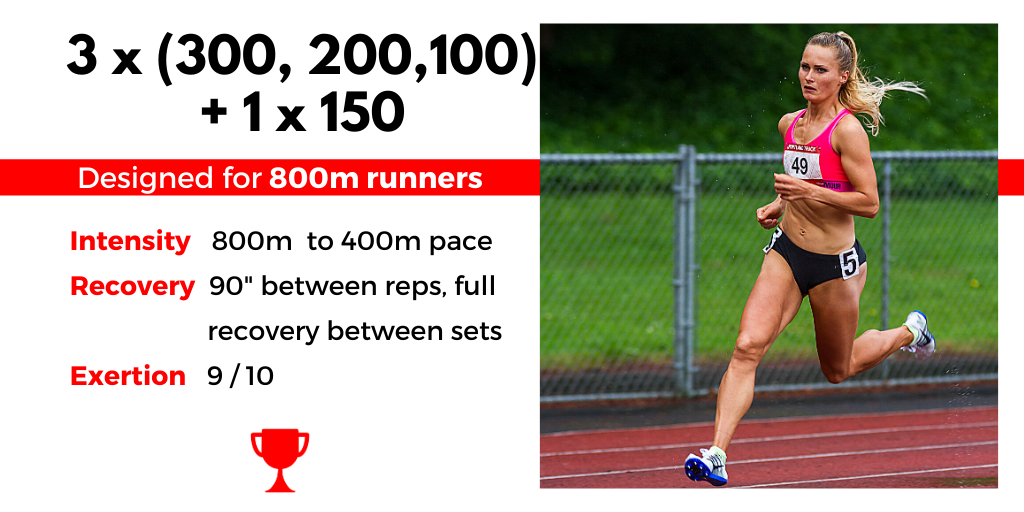3 x (300m, 200m, 100m) + 1 x 150m
3 x (300m, 200m, 100m) + 1 x 150m
Designed for 800m runners
Intensity
300m @ 800m speed
200m @ 400m speed
100m @ top speed
150m @ top speed
Recovery
90” between reps in a set
Full recovery as needed (8-15 minutes) between sets
Exertion
9/10
Periodization
Specific Period, Extension Block
Context & Details
If we think of 800m runners as “endurance sprinters” then training for the event gets really simple.
There are 3 main biomotor qualities that determine 800m performance ability. They are, in order:
Maximum speed
Lactate (or acidosis) tolerance
Maximum strength — both of the muscular and aerobic variety.
Running success, in any event, is a combination of both generic and training factors. Genetics determines the range within which a runner can improve. Training determines where a runner’s current abilities fall within their own genetic range.
All three of these biomotor qualities are trainable and should be make up the bulk of the 800m runner’s difficult training efforts throughout the season.
This workout specifically targets improvement of the runner’s Lactate Tolerance.
As a quick reminder:
Lactate Threshold training is aimed at delaying acidosis while Lactate Tolerance training is aimed at coping with acidosis. Lactate Threshold training does not help with acidosis tolerance. And Lactate Tolerance training does not improve Lactate Threshold. You can read more about the difference in this Super Running blog post.
Most Lactate Tolerance sessions are also called Speed-Endurance. The aim is to teach the body how to endure race speeds, coping with building amounts of fatigue and acidosis, so the 800m runner will decelerate less in the final stages of the race.
The construction of this workout with reps at high velocities combined with very short recovery periods create a highly acidic environment within the body.
From my experience, the runner usually first starts to feel and show the effects of fatigue and slow down somewhere in the final 100m of the 200m rep.
Ninety seconds rest is not enough time for lactate clearance to happen so this makes the 100m rep an exercise of sheer willpower.
Perhaps the first 20m-30m realistically can be run at top speed, the rest of the way the runner will feel like they’re running in sand — and that’s the point! The 100m rep should be very difficult due to the accelerating acidic environment caused by lactate flooding into the bloodstream. Exposure to this metabolic situation is needed to create the coping mechanisms to tolerate a high lactate environment on race day.
For the 800m runner to successfully endure multiple sets of this abrasive training, you need to allow for full recovery (lactate clearance) between sets. I typically allot recovery of 8 minutes after the first set and 15 minutes after the second set of walking, jogging, and standing around.
If enough recovery is not taken between sets, the “speed” element of the workout is quickly lost. If reps in subsequent sets become too slow then the workout no longer is training the desired qualities. Instead, it devolves into hard labor which only serves to make the athlete tired without a training effect.
The final 150m rep at top speed has more to due with training the mind than the body. Ideally, full recovery preceded this rep, so the runner has cleared much of the lactate out of their bloodstream going into this rep. More than anything the fast 150m is about reenergizing the 1/2 miler by finishing “fast” to help build back their confidence after enduring a difficult session.
Running fast is fun — especially for the 800m type.
Yes, the runner will be tired, but confidence is gained through demonstrated ability. This rep is designed to show the athlete they can run fast, even when tired. Don’t think of it as speed rep, but a confidence rep.
And don’t force it. It’s OK to scrap the final 150 if the athlete is completely drained. The purpose of this rep is to run fast, if they’re so taxed that can’t happen there is little point in performing a slow, death march. Instead, call it a day, cool-down, and go home.
A final word of caution: effective Lactate Tolerance sessions are very taxing and the recovery from these sessions can be slow, about 2 - 4 days in even highly trained runners. This makes Lactate Tolerance sessions less frequent training sessions, about once every 7 - 12 days. Don’t perform this type of session too close to race day, otherwise, the athlete will feel sloppy and slow in competition.
It’s also worth noting that for 800m runners, early-season dual meet triples consisting of an open 800m, 400m, and the 4x400m, are an excellent “session” that trains lactate tolerance in a competition setting. Middle distance runners only need about 6 of these sessions total over the course of 6-8 weeks to realize the full coping effects. After that, the training return sharply declines for the severity of the work performed.
Continue Learning
Join the Scholar Program for $29 to learn more about successful 800m Training and get unlimited access to courses and training programs on middle-distance running.
Good books on 800m training
Nick Symmonds' 2012 Training Log eBook via RunGum website
Winning Running by Seb Coe
Running Science by Own Anderson
Modern Training and Physiology for Middle and Long-Distance Runners by John Davis

